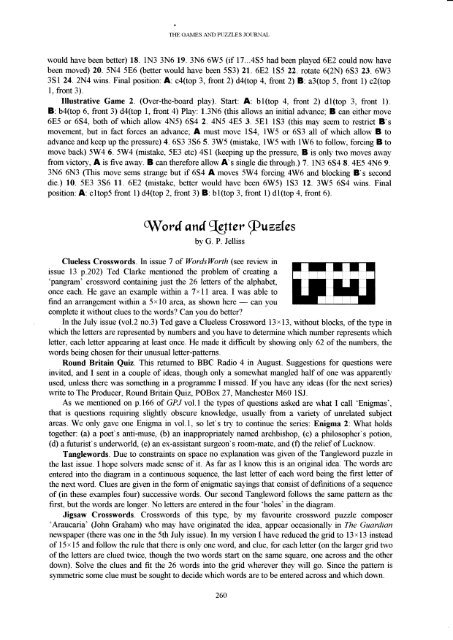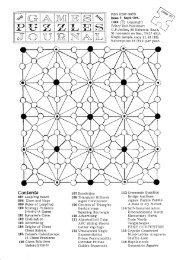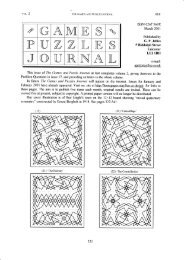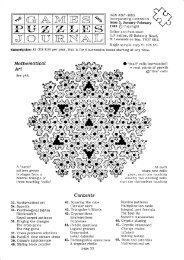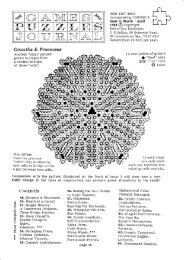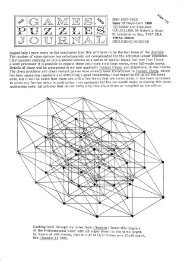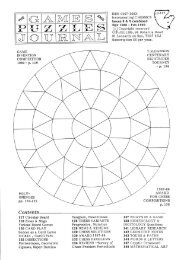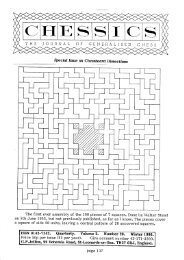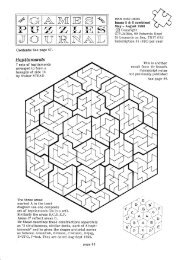The Games and Puzzles Journal, #15 - Mayhematics
The Games and Puzzles Journal, #15 - Mayhematics
The Games and Puzzles Journal, #15 - Mayhematics
Create successful ePaper yourself
Turn your PDF publications into a flip-book with our unique Google optimized e-Paper software.
TFIE GAMES AND PLIZZLES JOLTRNAL<br />
would have been better) f8. lN3 3N6 19. 3N6 6W5 (if 17...455 had be€n played 6E2 could now have<br />
been moved) 20. 5N4 586 (better would have been 5S3) 21. 6E2 1S5 22. rotate 6(2N) 653 23. 6\M3<br />
3S1 24. 2N4 wins. Final position: A: c4(top 3, front 2) d4ftop 4, front 2) B: a3(top 5, front 1) c2(top<br />
1, front 3).<br />
Illustrative Game 2. {Over-the-board play). Start: A: bl(top 4, front 2) dl{top 3, front 1).<br />
B: b4(top 6, front 3) da{top 1, front 4) Play: 1.3N6 {this allows an initial advance; B can either move<br />
6E5 or 634, both of which allow 4N5) 654 Z. 4N5 4E5 3. 5El lS3 (this may seem to restrict B's<br />
movement, but in fact forces an advance; A must move 1S4, 1W5 or 653 all of which allow B to<br />
advance <strong>and</strong> keep up the pressure) 4. 653 356 5. 3W5 (mistake, 1W5 with 1W6 to follow, forcing B to<br />
move back) 5W4 6. 5W4 (mistake, 583 etc) 4Sl (keeping up the pressure, B is only two moves away<br />
from victory, A is five away. B can therefore allow As single die through.) 7. 1N3 654 S. 4E5 4N6 9.<br />
3N6 6N3 (This move sems strange but if 654 A moves 5W4 forcing 4W6 <strong>and</strong> blocking B's second<br />
die.) 10. 583 336 lt. 6EZ (mistake, better would have been 6ril5) lS3 12. 3W5 654 wins. Final<br />
position: A: cltop5 front 1) d4(top 2, front 3) B: bl(top 3, front 1) dl(top 4, front 6).<br />
rybrdsndktter pusz[es<br />
by G" P. Jelliss<br />
Clueless Crosswords. In issue 7 of WordsWorth (see review in<br />
issue 13 p.7*21 Ted Clarke mentioned the problem of creating a<br />
'pangram' crossr,lard containing just the 26 letters of the alphabet,<br />
once each. He gave an example within a 7 xll area. I was able to<br />
find an arrangement within a 5x l0 areaj as shown here can you<br />
-<br />
conrplete it r,l-ithout clues to the words? Can y'ou do better?<br />
In the July issue (vol.2 no.3) Ted gave a Clueless Crossword l3x 13, without blocks, of the fpe in<br />
which the letters are represented by numbers <strong>and</strong> you have to determine which number represents which<br />
letter, each letter appearing at least once. He made it difficult by showing only 62 of the numbers, the<br />
words being chosen for their unusual letter-pattems.<br />
Round Britain Quiz. This returned to BBC Radio 4 in August. Suggestions for questions were<br />
invit€4 <strong>and</strong> I sent in a couple of ideas. though only a somewhat nrangled half of one was apparently<br />
used, unless there was something in a programme I missed. If you have any ideas (for the next series)<br />
write to <strong>The</strong> Producer, Round Britain Quiz, POBox 27, Manchester M60 lSJ.<br />
As we mentioned on p.166 of GPJ vol.l the tlpes of questions asked are what I call 'Enigmas',<br />
that is questions requiring slightly obscure knowledge, usually from a variety of unrelakd subject<br />
areas. We only gave one Enigma in vol.l, so let's try to continue the series: Enigma 2: What holds<br />
together: (a) a poet's anti-muse, (b) an inappropriately named archbishop, (c) a philosopher's potion,<br />
(d) a ftturist's underworl{ (e) an ex-assistant surgeon's room-mate, <strong>and</strong> (0 the relief of Lucknow.<br />
Tanglewords. Due to constraints on space no explanation was given of the Tangleword pu"zle in<br />
the last issue. I hope solvers made sense of it. As far as I larow this is an original idea. <strong>The</strong> words are<br />
entered into the diagram in a continuous sequence, the last letter of each word being the first letter of<br />
the next word. Clues are given in the form of enigmatic sayings that consist of definitions of a sequence<br />
of (in these examples four) successive words. Our second Tangleword follows the same pattern as the<br />
first, but the words are longer. No letters are entered in the four 'holes' in the diagram.<br />
Jigsaw Crosswords. Crosswords of this type, by my favourite crossword puzzle composer<br />
'Araucaria' (John Graham) who may have originated the ide4 app€r occasionally n <strong>The</strong> Guardian<br />
newspaper (there was one in the 5th July issue). In my version I have reduced the gdd to l3x 13 instead<br />
of 15x 15 <strong>and</strong> follow the rule that there is only one word, <strong>and</strong> clus, for each letter (on the larger gnd two<br />
of the letters are clued tr,vice, though the two words start on the same square, one across <strong>and</strong> the other<br />
dornn). Solve the clues <strong>and</strong> fit the 26 words into ilre grid wherever they will go. Since the pattem is<br />
rytnmetric some clue must be sought to decide which words are to be entered across <strong>and</strong> which down.<br />
260


